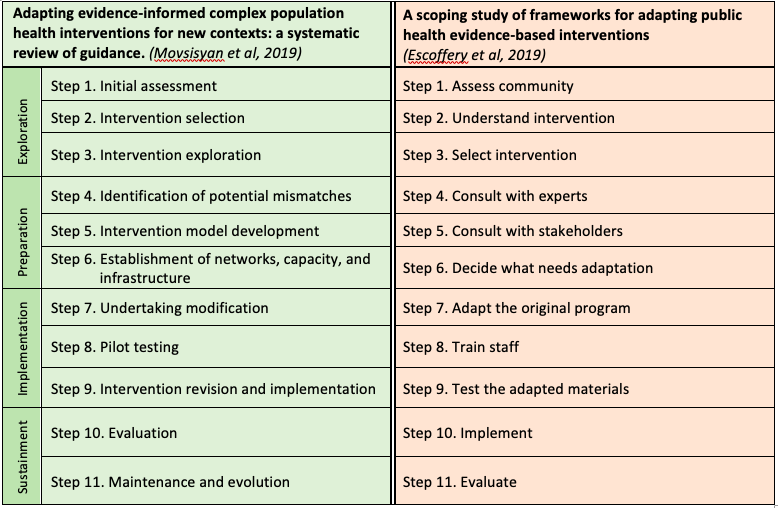Introduction
Population health problems are complex and “sticky,” often lacking an obvious or straightforward solution. If there is evidence that a policy, program, or practice works in one setting, community leaders may be inspired to try similar approaches in other places, to leverage experience and best practices, and to save time and money from not having to develop something from scratch. The extent to which an approach from one place can be adapted to a new setting with comparable success is therefore an important question.
Successful adaptation hinges on the extent to which an intervention can retain enough of the core components that made it work in the original setting and also be appropriately tailored to fit the new context. Adaptation must account for a variety of factors such as culture and norms, sociopolitical climate, delivery systems and infrastructure, and the capacity, needs, and preferences of the target population in the new setting. The process itself should also engage appropriate stakeholders to optimize local ownership and sustainability.
Adaptation therefore should follow a systematic process guided by theory and research. This means the overall approach should draw from one or more relevant frameworks, and each stage of the process should be informed by thoughtful investigation.
E4A’s recently released Call for Proposals – Approaches to Advance Gender Equity from Around the World – targets research focused on adapting successful initiatives from outside the United States to a U.S. setting. Given this particular interest, we’ve dedicated this blog post to the science of adaptation – the common stages and considerations that guide intervention adaptation, the types of research questions that may be asked at each stage of adaptation, and potential research approaches that can help answer these questions.
Possible Approaches
In practice, no single theory, model, or framework dominates or provides universal guidance on how to adapt evidence-based interventions – there are, in fact, multiple frameworks from which to choose, depending on specific topics and circumstances (see tools and resources).
Two recent studies have summarized these numerous approaches: Escoffery et al. (2019) and Movsisyan et al. (2019). While they differ slightly in content, both present common steps and sequencing found across multiple frameworks and studies.
Table: Summary and comparison of adaptation steps from two guiding studies

Example Research Questions
Regardless of which specific theoretical model or framework is used to guide an adaptation, different phases or steps correspond with different research questions and approaches.
For example, in early stages of adaptation, research questions should be aimed at discovering relevant aspects of the target population and intervention. They may ask:
- What is the population health problem faced by the community? What are the root causes?
- Surveillance studies, needs assessments, or community-based participatory research approaches can help determine the needs of the community and inform intervention selection.
- How strong is the evidence supporting an intervention? What are the contexts in which the intervention works?
- If an intervention has been implemented in various contexts but evidence has not been synthesized or compiled, then a systematic review or meta-analysis may be necessary to fully interpret effectiveness. Comparative case studies can also be important for comparing and generalizing findings across different contexts.
- What is the theory of change or the causal mechanism through which the intervention works? What conditions must be met?
- A theory of change analysis can identify or isolate the underlying mechanisms and behavioral processes that need to remain intact for successful adaptation. Implementation studies in the home country setting can shed light on factors that improve uptake, cost, coverage, acceptability, etc. in the original context.
In the middle stages of adaptation, research questions typically focus on feasibility. For example:
- To what extent is the intervention acceptable to the target population? How likely is uptake? What infrastructure is needed to facilitate uptake? Who are the stakeholders and partners who will be the adapted program’s implementors, champions, liaisons, ambassadors?
- Feasibility studies that explore multiple conditions help determine how viable the intervention will be and what modifications are needed. Stakeholder engagement may be investigated through a network analyses.
In later stages, when the modified program is being tested, implemented, or maintained in the new setting, research questions are concerned with evaluation – not just of outcomes, but also fidelity to the original approach, costs, sustainability, and other components for long-term success. Questions may include:
- What is the impact of the intervention on outcomes of interest, comparing people exposed to the program to an equivalent population unexposed?
- This may entail an efficacy trial, pilot study, or large-scale outcome evaluation.
- To what extent is the program adopted? How much penetration into the target community is achieved? What is the cost-effectiveness?
- Implementation studies or a cost-benefit assessment in the new setting can help answer these questions.
For the purposes of our CFP focused on adapting gender equity interventions, we are most interested in questions related to stages of adaptation that occur after the population has been assessed, but before the adaptation is evaluated for outcomes or impact in the U.S. Research on the outcomes or impact of the adapted intervention in the U.S. may be funded through our on-going Innovative Research to Advance Racial Equity call for proposals.
Putting Evidence into Practice
Though adaptation steps have been presented and described here in a linear format for simplicity, it is common in practice for some steps or stages to overlap or occur concurrently, and others to be collapsed. Yet the overall consensus from research and practice is that adaptation is a process, not a singular feat, and that certain benchmarks must be reached before moving on to the next stage. For example, it is generally necessary to establish acceptance or feasibility of an adapted intervention before focusing on outcomes or impact.
A theoretically sound framework that is appropriate to a specific type of intervention will lay out what the stages or benchmarks should be. Strong evidence at key intervals will guide decision-making about subsequent stages and is essential to ensuring the success and sustainability of the adapted intervention.
Tools & Resources
Researchers, practitioners, and policy makers who are engaged in adaptations may find it useful to consult either of the two summary studies to help select an appropriate theory or framework to guide their work.
- Escoffery, C., Lebow-Skelley, E., Udelson, et al. A Scoping Study of Frameworks for Adapting Public Health Evidence-Based Interventions. Translational Behavioral Medicine 9 (1): 1–10 (2019).
- Movsisyan, A., Arnold, L., Evans, R. et al. Adapting evidence-informed complex population health interventions for new contexts: a systematic review of guidance. Implementation Sci 14, 105 (2019).
In addition, there are many tools and approaches to guide research or evaluation at various stages of adaptation. The following is a small sample of guidance available in published and gray literature; this is not meant to be a comprehensive selection, but to present examples of approaches at each respective stage:
